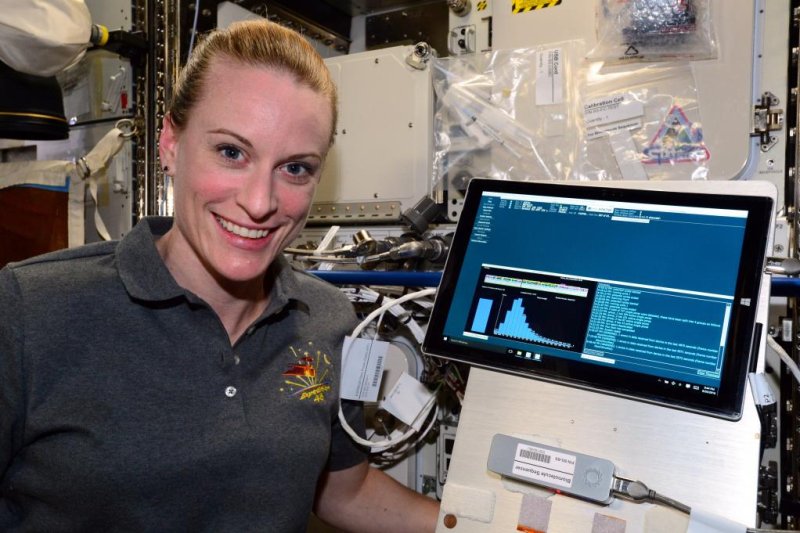NASA astronaut Kate Rubins poses with MinION, the device that DNA-sequencing possible in space for the first time. Photo by NASA
SAN FRANCISCO, Aug. 31 (UPI) -- For the first time, scientists sequenced DNA in space. NASA astronaut Kate Rubins sequenced mouse, bacteria and virus DNA while aboard the International Space Station. She beamed the results back to Earth for analysis.
The work is part of the Biomolecular Sequencer project, an effort by NASA and partners to identify how space travel might affect genes and gene expression. Scientists at the University of California, San Francisco and Weill Cornell Medical College are now comparing the results to DNA samples sequenced on Earth.
Though there are likely to be differences worth exploring, the initial results show strong similarities, suggesting the space-based sequencing technology is effective.
The technology that allowed Rubins to sequence the genome samples is called MinION. It's a USB-powered, pocket-size device that employs a strategy called nanopore sequencing. The process sends an ionic current through the tiny holes of cell membranes. As DNA molecules are squeezed through the holes, changes to the sensitive ionic current are recorded. The process can take as little as ten minutes.
"Up until recently technology for sequencing in space hasn't been available because sequencers are generally large bulky instruments," researcher Charles Chiu, director of the UCSF-Abbott Viral Diagnostics and Discovery Center, explained in a news release.
There was concern among scientists that microgravity would disrupt the performance of the microfluidics in MinION, but that turned out not to be the case.
"We essentially got equivalent data, and it's of very high quality, probably within the top 20 percent of nanopore runs that we do routinely here on Earth," Chiu said.
For the initial tests, DNA samples were prepared on Earth and sent to ISS for sequencing. In future experiments, researchers will be able to prepare samples, sequence the DNA and analyze the results all while circling 200 miles above the Earth.
The technology could help diagnose sick astronauts and identify alien life forms.
"Onboard sequencing makes it possible for the crew to know what is in their environment at any time," Sarah Castro-Wallace, NASA microbiologist and project manager, said in a NASA update. "That allows us on the ground to take appropriate action -- do we need to clean this up right away, or will taking antibiotics help or not? We can resupply the station with disinfectants and antibiotics now, but once crews move beyond the station's low Earth orbit, we need to know when to save those precious resources and when to use them."















